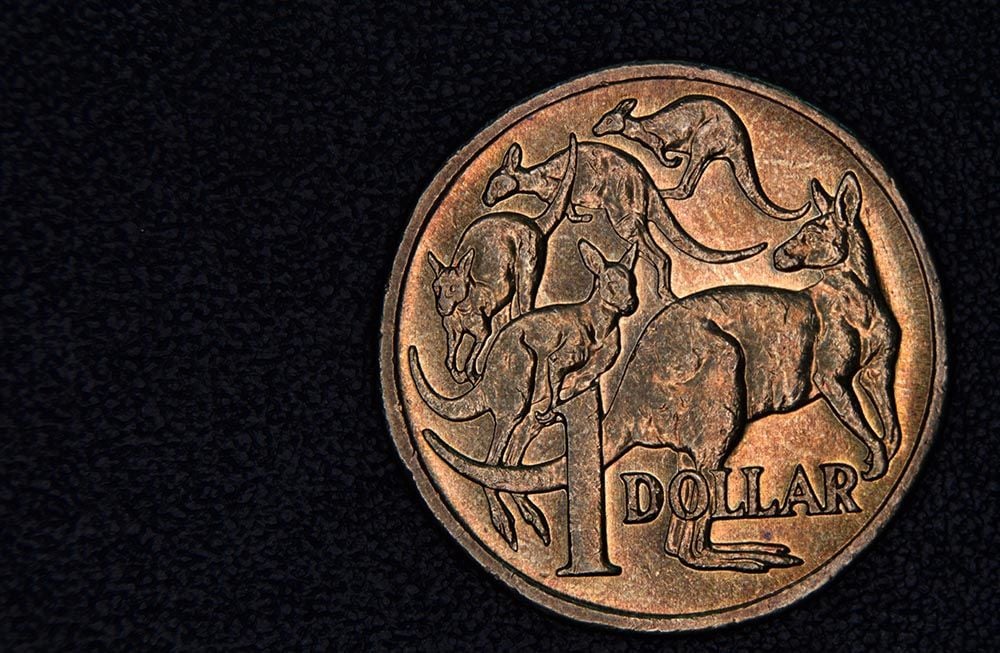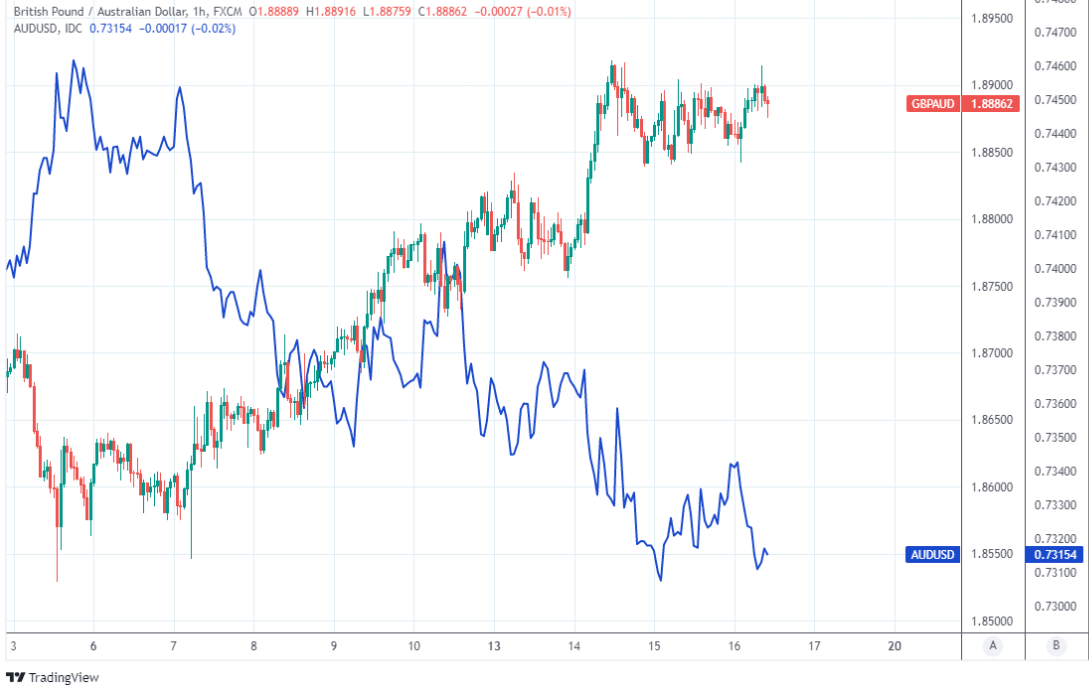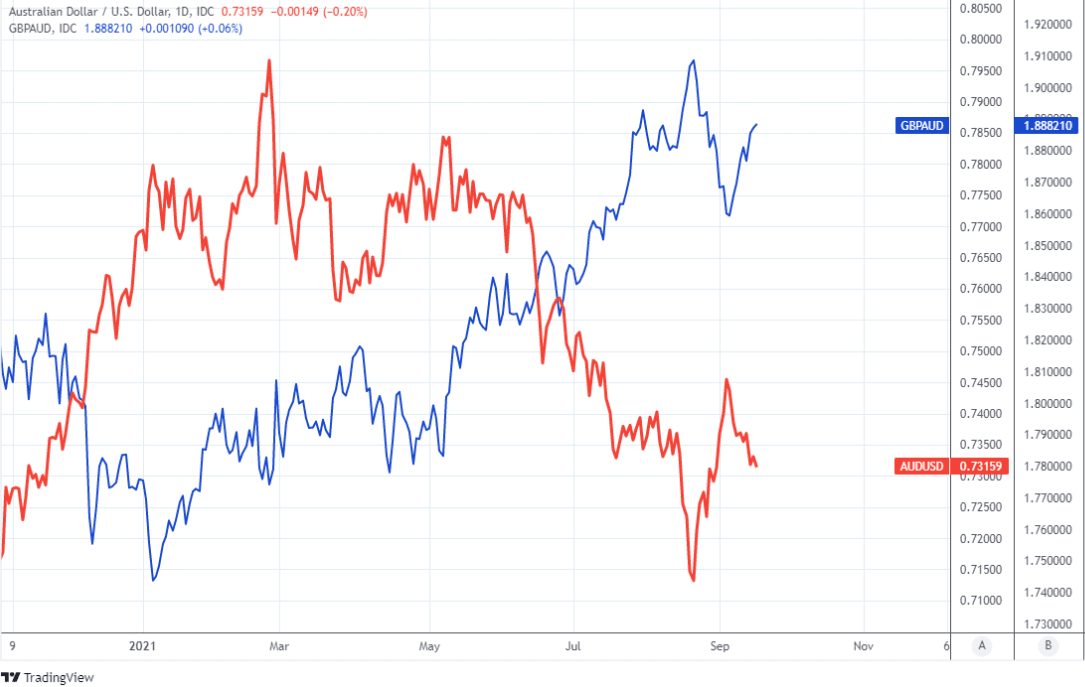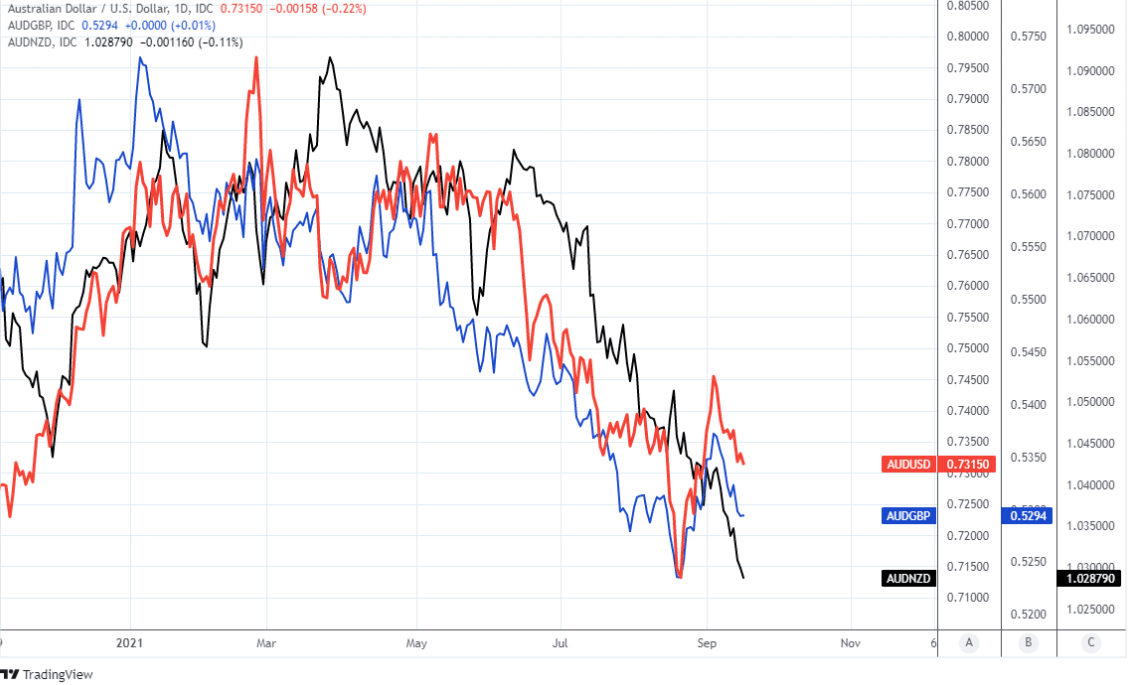Pound-Australian Dollar Gains Could Fade Ahead of 1.92
- Written by: James Skinner
- GBP/AUD attempts to recover 1.89 ahead of weekend
- May see levels close to 1.92 on any fresh AUD declines
- Could slip to 1.8676 on further AUD attempt at recovery
- Would leave GBP/AUD’s 2021 uptrend intact on the charts

Image © Adobe Images
- GBP/AUD reference rates at publication:
- Spot: 1.8890
- Bank transfer rates (indicative guide): 1.8230-1.8362
- Money transfer specialist rates (indicative): 1.8720-1.8800
- More information on securing specialist rates, here
- Set up an exchange rate alert, here
The Pound-Australian Dollar rate was testing September highs above 1.89 in the penultimate session of the week and may even be seen closer to 1.92 in the weeks ahead, although if the Aussie attempts to renew August’s recovery it could push GBP/AUD as low as 1.8676.
Australia’s Dollar was close to the bottom of the major currency league table for the week overall on Thursday but doing much better on an intraday basis despite Australian Bureau of Statistics data that confirmed Australia’s largest loss of jobs in August since the initial ‘lockdown’ of 2020.
Employment fell -146.3k last month, reversing almost all of the job gains made during the preceding three months following a period in which major urban population centres and economic hubs were forced back into shutdown by a fresh outbreak of the coronavirus.
“We expect the labour force data will deteriorate further in September because it will also pick up the lockdown in Victoria,” says Kim Mundy, a currency strategist at Commonwealth Bank of Australia. "We do not expect the soft labour market data will be an enduring weight on AUD."
The Australian Dollar showed resilience on Thursday despite the data, posting gains over European currencies like the Norwegian Krone and Swedish Krona but lagging the other anglospheric commodity currencies like the Kiwi and Canadian Dollars.
The Pound-Australian Dollar rate rose in an attempt to overcome the 1.89 handle that was ceded during late August’s corrective fall, which took place as the AUD/USD exchange rate attempted to draw a line under eight months worth of declines.
Above: Pound-to-Australian Dollar rate shown at hourly intervals alongside AUD/USD.
Secure a retail exchange rate that is between 3-5% stronger than offered by leading banks, learn more.
“The Reserve Bank of Australia’s commitment to its tapering of weekly asset purchases suggests AUD will not be re-rated downwards,” Mundy says.
Economists and policymakers at the Reserve Bank of Australia see employment levels recovering quickly as and when the economy reopens, and few if any see the central bank likely to provide further support to the economy through either its bond buying programme or interest rate going forward.
This spares the Australian Dollar from what might otherwise be an overbearing risk to market appetite for it, although the persistence of ‘lockdown’ and the risk of further government measures that could eventually limit the economy’s recovery are still having an effect on RBA policy and the Aussie.
“Although the RBA this month stuck to the previously announced decision to taper its asset purchase programme, it did state that it would not consider another taper until February, making it a fairly dovish tapering announcement,” says Jane Foley, head of FX strategy at Rabobank.
“In our view AUD/USD is at risk of another dip lower below 0.72 in the coming weeks. This assumes the USD can stay on the front foot,” Foley says.
{wbamp-hide start}
{wbamp-hide end}{wbamp-show start}{wbamp-show end}
Foley also cites recent declines in prices of Australia’s top export, iron ore, alongside concerns about the Chinese economy and political tensions between the two countries as further headwinds to market appetite for the Australian Dollar.
However, she and others have noted that the main and likely enduring burden on antipodean currency over the medium term is the RBA’s assessment that “wages will need to be growing by at least 3% to push CPI inflation sustainably into the middle of the 2% to 3% target band.”
“We’re not going to raise the cash rate until inflation is sustainably within the two-to-three percent range,” said Philip Lowe, Governor at the Reserve Bank of Australia, in an address to the Anika Foundation this Tuesday.
“On bond purchases we expect to have certainly tapered and then stopped those before we reach that target for inflation. What we’re wanting to see is substantial progress toward those goals; the goal of getting back to full employment and inflation in a two-to-three percent range,” Lowe said.
The ongoing risk for the Australian Dollar and source of support for GBP/AUD is that the RBA’s now-delayed tapering of its quantitative easing programme leads financial markets to recognise that current market expectations for the bank’s interest rate are unsustainable.
Above: AUD/USD shown at daily intervals alongside GBP/AUD.
This is a part of why the AUD/USD exchange rate has struggled to sustain the August recovery that pushed GBP/AUD from around 1.92 mid-month to a low of 1.85 in early September.
Financial markets have been slow to get the message and were actually assuming in September that the RBA would be almost as quick to raise its cash rate than was previously assumed back in the latter half of June 2021.
Pricing in the overnight-index-swap market still assigned a high probability on Thursday to the idea that the RBA’s cash rate would rise from 0.10% to 0.25% by late 2022, creating a risk and headwind for the Aussie in the process.
“At the same time, external developments have not been favourable for the Australian dollar. The latest monthly activity data from China continued to reveal a further loss of growth momentum,” says Lee Hardman, a currency analyst at MUFG.
“Overall we continue to remain cautious over the near-term outlook for the Aussie and recommend a short AUD/NZD trade idea,” Hardman adds.
Above: AUD/GBP, AUD/USD and AUD/NZD shown at daily intervals.
Back in June Australia enjoyed a strong economic recovery and expectations for interest rates were rising globally after the Federal Reserve suggested that it could raise rates in 2023, although since then the country has been subjected to its longest-lived and most draconian ‘lockdown’ seen to date.
All of these headwinds down under are supportive of the Pound-Australian Dollar rate, which could rise as far as 1.9198 over the coming weeks if the main Aussie exchange rate AUD/USD slips back below the nearby 0.73 level.
Pound-Aussie losses would be likely however, if AUD/USD makes another attempt at recovery in the weeks ahead, although these losses would likely fade around 1.8676 if the earlier 0.7450 high in AUD/USD proves too much for the Aussie to overcome.
That would leave in place the appearance of a steady uptrend on the charts for the Pound-to-Australian Dollar rate, which always closely reflects developments in the two main exchange rates AUD/USD and GBP/USD.
Sterling has traded in a steady and sideways range that has for the most part spanned the gap between 1.38 and a little over 1.39 against the U.S. Dollar in September and this has helped to sustain the Pound-Australian Dollar rate uptrend.








